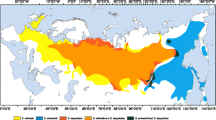Abstract
Senecio smallii andS. tomentosus occasionally hybridize on the granitic flatrocks of the Piedmont of the Southeastern United States. These hybrids are intersectional crosses between sectionsAurei andTomentosi. The parental species have different chromosome numbers withn = 22 inS. smallii andn = 23 inS. tomentosus. Meiosis in the hybrids is abnormal with 22ns and li or 2iis and 3is, and the percentage of stainable pollen is greatly reduced over that of the parents. The hybrid pollen grains are structurally abortive as demonstrated by the scanning electron microscope. Origin of the natural hybrids was documented by the production of artificial hybrids including F1’s, F2’s, and BC’s. Very few of the F2 seeds germinated, and all of the F2 seedlings later died, indicating hybrid breakdown. Seeds of the F1 and BC generations germinated well, and the seedlings were vigorous. Population samples indicate that there is some variation within the natural population systems; however, no evidence of introgression was detected. The isolating mechanisms and possible evolutionary effects of this natural hybridization are discussed.
Similar content being viewed by others
Literature Cited
Anderson, E. 1949. Introgressive Hybridization. New York: John Wiley & Sons. ix + 109 pp.
Barkley, T. M. 1962. A revision ofSenecio aureus Linn, and allied species. Trans. Kansas Acad. Sci.65: 318–408.
Burbanck, Madeline P. &R. B. Platt 1964. Granite outcrop communities of the Piedmont Plateau in Georgia. Ecology45: 292–306.
Greensnan, J. M. 1901. The genusSenecio in New England. Rhodora3: 3–7.
Jones, S. B., Jr. 1968. Chromosome numbers in Southeastern United States Compositae, II. Bull. Torrey Bot. Club95: 488,489.
MeVaugh, R. 1943. The vegetation of the granitic flat-rocks of the Southeastern United States. Ecol. Monographs13: 119–165.
Ornduff, R., T. Mosqnin, D. W. Kyhos, &P. H. Raven 1967. Chromosome numbers in Compositae. VI. Senecioneae. II. Amer. Jour. Bot.54: 205–213.
Radford, A. E., H. E. Ahles, &C. R. Bell 1964. Guide to the Vascular Flora of the Carolinas with Distribution in the Southeastern States. Chapel Hill, North Carolina: The Book Exchange, Univ. North Carolina. 383 pp.
Runemark, H. 1970. The role of small populations for the differentiation in plants. Taxon19: 196–201.
Ware, S. A. &Elsie Quarterman 1969. Seed germination in cedar gladeTalinum. Ecology50: 137–140.
Author information
Authors and Affiliations
Rights and permissions
About this article
Cite this article
Chapman, G.C., Jones, S.B. Hybridization between Senecio smallii and S. tomentosus (Compositae) on the granitic flatrocks of the Southeastern United States. Brittonia 23, 209–216 (1971). https://doi.org/10.2307/2805436
Issue Date:
DOI: https://doi.org/10.2307/2805436




